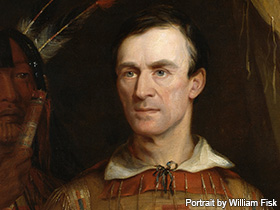Native Americans; Mandan Sioux; Philadelphia Academy of Art; Smithsonian Institution
In 1796, George Catlin entered the world and began an early interest in American Indians. He embraced American Indian cultures and attempted to preserve their history through sketching and painting portraits of them as well as penning many books. He traveled the country, documenting their lives and learning about their cultures.
George Catlin was born in Wilkes-Barre, Pennsylvania, to farmers Putnam and Polly Catlin in 1796. He had his first direct contact with American Indians at a young age when they captured his mother. He attended Wilkes-Barre Academy and went on to study law at Litchfield Law School in Connecticut. After practicing law in Luzerne County, however, he discovered that he preferred drawing and painting portraits. Catlin was accepted into the Philadelphia Academy of Art, and in 1826 he painted his first portrait of the Seneca Indian Red Jacket. In 1828, he married Clara Bartlett Gregory, with whom he had four children.
Documenting the lives, rituals, and faces of Indians in North and South America through writing and painting was Catlin's passion. He was one of the first to preserve and respect the Native American culture. He was the first to envision the idea of a national park to protect the diminishing bison Indian populations. Catlin and his wife traveled around the United States and also to Europe. In 1832, Catlin painted the Mandan Sioux, just five years before the tribe was decimated by smallpox and forced to merge with the Arikara Sioux. He also tried to persuade the United States Government to create a National Museum of the American Indian, but they did not grant his wish due to lack of public interest in the Indians.
Catlin died in Jersey City, New Jersey, on December 22, 1872, and was buried in Green-Wood Cemetery in Brooklyn, New York. He is remembered as one of the first people to actively respect the Native American Indians and show interest and compassion towards them. He documented the cultures of many tribes, such as the nations of the Iroquois Confederation (Seneca, Oneida, Tuscarora), Lakota, Ottawa, Mohegan, Ojibwa, Chinook, and more. His collection of paintings is now held at the Smithsonian Institution.
- Catalogue of Catlin's Indian Gallery of Portraits, Landscapes, Manners, Customs, Costumes, &c. New York: Piercy & Reed, 1837.
- Catlin's North American Indian Portfolio of Hunting Scenes and Amusements. London: Published by the author, 1844.
- The Breath of Life, or Mal-Respiration. And Its Effects upon the Enjoyment & Life of Man. New York: J. Wiley, 1861. Republished as Shut Your Mouth. New York: 1864.
- O-Kee-Pa; A Religious Ceremony. Philadelphia: Lippincott, 1867.
- North and South American Indians. Catalogue Descriptive and Instructive of Catlin's Indian Cartoons. New York: Baker & Godwin, 1871.
- "George Catlin." The Gale Literary Database: Contemporary Authors Online. 2 Mar. 2001. Mar. 2001. <>http://www.galenet.com>.
George Catlin, best known for his books and journals depicting Native American culture, was born in Wilkes-Barre in 1796.

